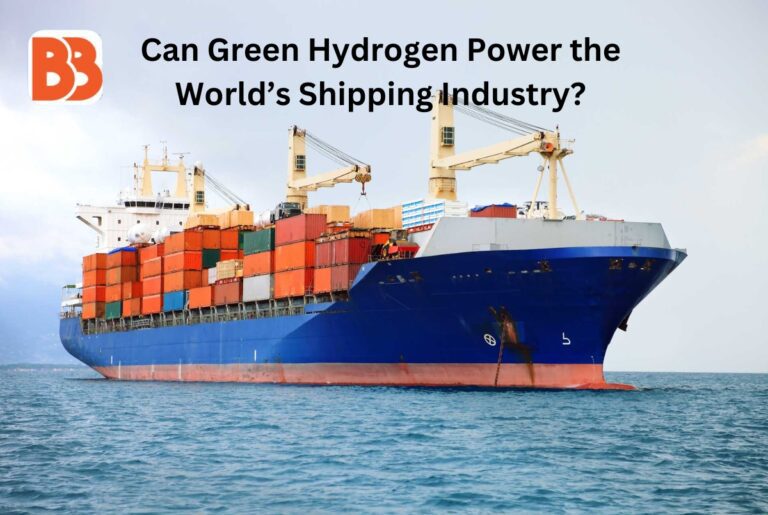As the world pushes toward decarbonization and more sustainable practices, the question arises Can green hydrogen power the world’s shipping industry? While the potential is immense, the transition from traditional marine fuels to green hydrogen will require overcoming several challenges related to technology, infrastructure, and costs. Let’s explore the potential of green hydrogen as a fuel for the shipping industry and the steps needed to make this transition feasible.
The Appeal of Green Hydrogen
Green hydrogen is produced through the electrolysis of water, powered by renewable energy sources like wind or solar. Unlike grey or blue hydrogen, it emits zero carbon emissions during production. This clean fuel is being increasingly seen as a viable alternative for industries struggling to decarbonize, such as heavy transportation, aviation, and shipping.
For the shipping industry, which is heavily reliant on bunker fuel, a high-emission fossil fuel, switching to a sustainable fuel like green hydrogen could drastically reduce its carbon footprint. This aligns with the International Maritime Organization’s (IMO) 2050 targets to reduce the sector’s greenhouse gas emissions by 50% compared to 2008 levels.
The Benefits of Green Hydrogen for Shipping
Zero Carbon Emissions
Green hydrogen, when used in fuel cells or burned in modified engines, emits only water vapor and heat as byproducts. This eliminates CO₂, sulfur oxides, and nitrogen oxides, which are currently prevalent in shipping emissions.
Decentralized Energy Production
Hydrogen can be produced locally, reducing reliance on global supply chains for fossil fuels. This could make it easier for ports around the world to generate hydrogen using locally available renewable energy, supporting a decentralized, resilient fuel supply.
Energy Density
Hydrogen has a high energy-to-weight ratio, making it an efficient fuel for long-haul journeys. Though its energy density by volume is lower than fossil fuels, technological advancements, such as the use of liquefied hydrogen, could improve its viability for large-scale shipping.
Challenges in Transitioning to Green Hydrogen
Despite its potential, green hydrogen is not without its challenges, especially for the shipping industry.
Storage and Transport
Hydrogen has a low energy density by volume, requiring it to be stored under high pressure or at cryogenic temperatures when liquefied. This complicates both storage on ships and transport to fueling stations, especially for large container vessels that require significant fuel capacity for long voyages.
Infrastructure Development
Transitioning to green hydrogen will require significant infrastructure changes at ports to support hydrogen production, storage, and distribution. Hydrogen refueling stations for ships, pipelines, and hydrogen storage tanks need to be developed. And the costs associated with building these systems are substantial.
High Costs
Green hydrogen is currently more expensive than conventional marine fuels due to the costs associated with electrolysis and renewable energy. According to estimates, the cost of green hydrogen is around $6 to $7 per kilogram. But for it to be competitive with traditional fuels, this needs to fall below $2 per kilogram. Scaling up production and increasing demand could drive down costs, but this will take time.
Technological Development
While hydrogen fuel cells are already being used in some sectors, the technology still needs to be optimized for large shipping vessels. Efforts are underway to develop hydrogen-powered engines and fuel cells that can handle the power requirements of shipping’s largest cargo ships. But these innovations are still in the early stages of commercialization.
Early Adoption and Pilot Projects
Despite these challenges, several countries and companies are already exploring green hydrogen as a fuel for the shipping industry. Norway, for instance, has been a leader in this space, with projects like the Hydra ferry, which will be the world’s first liquid hydrogen-powered vessel. Japan is also investing in green hydrogen ships through partnerships like the Kawasaki Heavy Industries’ Suiso Frontier, a pilot project that involves a hydrogen-powered cargo ship.
In addition to ship development, some major shipping companies are making commitments to hydrogen adoption. Maersk, one of the largest global shipping companies, has committed to decarbonizing its fleet by 2050 and is exploring green hydrogen as one of the potential solutions to meet this goal.
The Future Outlook
The decarbonization of shipping is an urgent priority in the fight against climate change. While green hydrogen presents one of the most promising solutions for achieving this. The path to widespread adoption is still long and uncertain. Continued investments in renewable energy, technological development. And infrastructure will be key to making green hydrogen a viable alternative for the shipping industry. Governments and international bodies will also play a critical role. By setting carbon pricing mechanisms, offering subsidies for green hydrogen projects. And enforcing stricter emissions standards, they can accelerate the shift to sustainable fuels. You can read more about “Green Hydrogen vs. Blue and Grey Hydrogen: What’s the Difference?“. Additionally, collaborative efforts between the shipping industry, hydrogen producers. And renewable energy developers will be vital to creating a cohesive supply chain for green hydrogen in the maritime sector.
Conclusion
Green hydrogen holds the potential to power the shipping industry of the future, drastically reducing carbon emissions and helping the sector align with global climate targets. However, significant challenges related to cost and technology. And infrastructure need to be overcome before hydrogen can replace fossil fuels on a large scale. As more countries and companies invest in hydrogen-powered ships and green hydrogen production. The world moves one step closer to a sustainable, decarbonized maritime industry. In time, with the right advancements and global collaboration, green hydrogen could become the fuel that powers the shipping industry, steering it toward a greener future.
